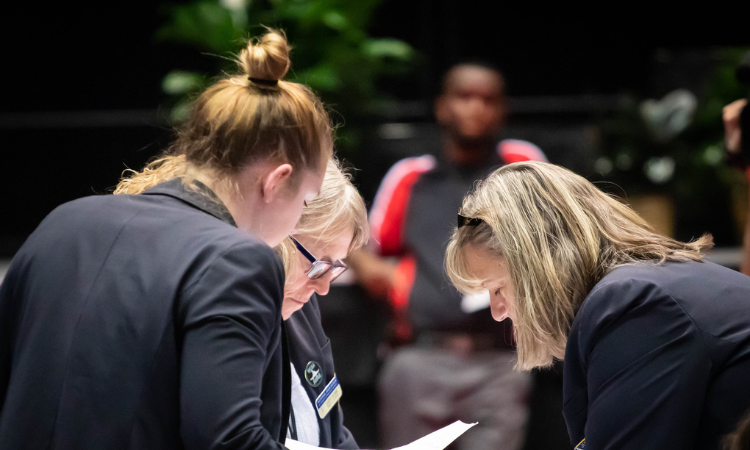The last article of this series is dedicated to judging NCAA floor, which is often the most crowd-pleasing and attention-grabbing event of the competition. This is where an athlete’s and team’s personality, showmanship and artistry can really shine through, and ideally is a perfect blend between the artistic and acrobatic components of gymnastics. Judging floor (I’m happy to say) is probably also one of the most straight-forward and easily understood of the four events, with a couple notable exceptions that can derail a seemingly perfect routine.
Evaluating Artistry
Each athlete on floor and beam is evaluated on the “artistry” of their performance. In my opinion, the whole notion of trying to objectively evaluate art seems impossible since the point of art is self-expression and open to individual interpretation. But I digress.
In NCAA gymnastics, artistry deductions are up to three tenths off and are equally weighted between “lack of variety in choreography,” “quality of movement to reflect personal style” and “quality of expression.” As you can see, these are super subjective and poorly defined, so for a judge to actually take one of these deductions in NCAA, it would have to be a major error or break in the routine.
For example, if a female gymnast did a men’s gymnastics style routine with no choreography, walking between required elements and having no expression, I would take the full three tenths. If an athlete accidentally flew off the floor in her routine and had to run clear across the floor to catch up to her choreography, I would take off artistry for that as well.
Other cases are less clear, though. In NCAA, a safe bet for deduction-less artistry is any routine where the gymnast is smiling, having a good time, making it look easy and getting the crowd involved. I can’t imagine a scenario where these routines would incur any artistry deductions. Since these are college students primarily performing live for other college students, these high-energy, sassy, hip-hop infused, bass-heavy floor routines are a smart move for a college coach to put in the lineup. However, these aren’t the only type of floor routines that are acceptable. For me, the best routines are ones where the expression and choreography tell a story—like this gorgeous routine from Brooklyn Moors—and it doesn’t always have to be a happy one or one that makes you feel like you’re at the club.
Floor Deductions
Most floor deductions are easily spotted by a viewer at home, such as going out of bounds, leg and foot form during dance and acrobatic elements or the control and body position of the landings at the end of the tumbling pass. The Code of Points allows for a “controlled step” into a lunge without deduction following a tumbling pass. Whether or not a step is considered “well controlled” can vary from judge to judge, and I would say judges are consistently more lenient in college with allowing for some very large “controlled” steps into a lunge following a powerful tumbling pass. However, if an athlete under-rotates their salto and takes a step, even if it’s “controlled,” it still incurs a landing deduction since the step was due to an underpowered, not overpowered, tumbling pass.
Some more subtle deductions are the amplitude of the major saltos, precision of turns or twists in leaps, jumps and saltos, and the composition of the routines. Composition deductions on floor, like on beam, are rare. Some of the compositional requirements are a variety of acrobatic and dance elements, a consistent distribution of the difficult elements throughout the routine, and use of the entire floor exercise. The athletes and coaches at the NCAA level are experienced and familiar with these requirements and can expertly compose routines that play to an athlete’s strengths while meeting all the specific compositional requirements.
The Dance Pass
The most difficult and sometimes most important point of evaluation in an athlete’s floor routine is their dance pass. Every gymnast must have some sort of leap (one foot take off) to a full front or side split, directly or indirectly connected to another dance element.
Most athletes perform dance elements valued at a C or higher, making the gymnast eligible for difficulty or connection bonus. These elements often require a combination of leaping, jumping, splitting and/or turning, which makes them more difficult to perform and judge. To incur no deduction, all leaps and jumps must show amplitude, an even split of at least 180 degrees, perfect leg and foot form, good body posture and precise take-offs and landings, especially for turning jumps or leaps.
As you can imagine, this is a lot for a judge’s eye to take in simultaneously, especially since there are at least two elements right in a row that must be evaluated. It’s very easy to “cheat” the turn on these skills by starting or finishing some of the turn while your feet are still on the ground. The hips might look square and straight, but the feet can be turned by a quarter turn (90 degrees) or more. Judges look at the alignment of the feet to determine whether or not each jump has fully completed the turn. If the degree of turn on the landing is not precise, athletes can incur a deduction.
For example, in this beautiful 10.0 routine from Minnesota’s Mya Hooten last season, Hooten overturns her switch side leap by almost a quarter turn, which means she slightly under turns her straddle full after. Could the judges see it in real time? Likely not, or at least not clearly enough to take away that perfect 10.0 routine. But if they had seen it, she would have incurred a half- to one-tenth deduction on her leap pass. And had she been in front of FIG judges, she would definitely have received a deduction.
Perfect-Enough 10.0
Another area that judges tend to turn a blind eye is foot form on round-offs, back handsprings and front handsprings in tumbling. It’s important to remember that judges are supposed to evaluate every element an athlete does, not just the big salto at the end of the pass. If you watch closely, Kyla Ross (UCLA) has some very flexed feet in her round-offs in this perfect 10.0 routine. Should this routine score well? Absolutely. But should it get the same score as another stellar athlete that points her toes in her roundoff? According to the rules, no. But in many cases, an NCAA judge would be hard-pressed to nit-pick a half-tenth deduction for flexed feet on a round-off and take away a perfect 10.0 from an otherwise perfect routine, especially on a televised, lights-out performance from an Olympic gold medalist.
READ THIS NEXT: Judge’s Inquiry: Rhythm, Composition and Deductions Not Commonly Taken on Beam
Article by Rhiannon Franck
Rhiannon Franck is a former national-rated NAWGJ women’s gymnastics judge with over 15 years of USAG judging experience and nine seasons judging NCAA gymnastics. Outside of gymnastics, Franck works at a university as a nursing professor and loves to travel. You can follow her on Instagram and Twitter.
Like what you see? Consider donating to support our efforts throughout the year!



One comment